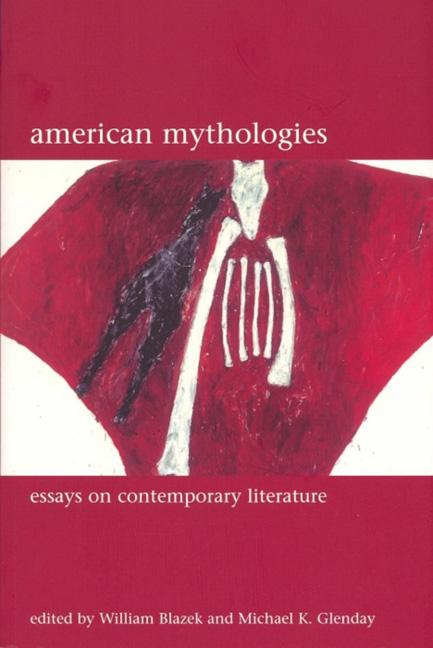Book contents
- Frontmatter
- Dedication
- Contents
- Acknowledgements
- Introduction
- 1 Indians with Voices: Revisiting Savagism and Civilization
- 2 Wild Hope: Love, Money and Mythic Identity in the Novels of Louise Erdrich
- 3 Float Like a Butterfly, Sting Like a Bee: Mythologies of Representation in Selected Writings on Boxing by Norman Mailer
- 4 The Secret Sharing: Myth and Memory in the Writing of Jayne Anne Phillips
- 5 The Individual's Ghost: Towards a New Mythology of the Postmodern
- 6 ‘Cheap, On Sale, American Dream': Contemporary Asian American Women Writers’ Responses to American Success Mythologies
- 7 ‘No Way Back Forever’: American Western Myth in Cormac McCarthy's Border Trilogy
- 8 Native American Visions of Apocalypse: Prophecy and Protest in the Fiction of Leslie Marmon Silko and Gerald Vizenor
- 9 The Brave New World of Computing in Post-war American Science Fiction
- 10 Mythologies of ‘Ecstatic immersion’: America, The Poem and the Ethics of Lyric in Jorie Graham and Lisa Jarnot
- 11 Whose Myth is it Anyway? Coyote in the Poetry of Gary Snyder and Simon J. Ortiz
- 12 Aging, Anxious and Apocalyptic: Baseball's Myths for the Millennium
- 13 Finding a Voice, Telling a Story: Constructing Communal Identity in Contemporary American Women's Writing
- Notes on Contributors
- Index
12 - Aging, Anxious and Apocalyptic: Baseball's Myths for the Millennium
- Frontmatter
- Dedication
- Contents
- Acknowledgements
- Introduction
- 1 Indians with Voices: Revisiting Savagism and Civilization
- 2 Wild Hope: Love, Money and Mythic Identity in the Novels of Louise Erdrich
- 3 Float Like a Butterfly, Sting Like a Bee: Mythologies of Representation in Selected Writings on Boxing by Norman Mailer
- 4 The Secret Sharing: Myth and Memory in the Writing of Jayne Anne Phillips
- 5 The Individual's Ghost: Towards a New Mythology of the Postmodern
- 6 ‘Cheap, On Sale, American Dream': Contemporary Asian American Women Writers’ Responses to American Success Mythologies
- 7 ‘No Way Back Forever’: American Western Myth in Cormac McCarthy's Border Trilogy
- 8 Native American Visions of Apocalypse: Prophecy and Protest in the Fiction of Leslie Marmon Silko and Gerald Vizenor
- 9 The Brave New World of Computing in Post-war American Science Fiction
- 10 Mythologies of ‘Ecstatic immersion’: America, The Poem and the Ethics of Lyric in Jorie Graham and Lisa Jarnot
- 11 Whose Myth is it Anyway? Coyote in the Poetry of Gary Snyder and Simon J. Ortiz
- 12 Aging, Anxious and Apocalyptic: Baseball's Myths for the Millennium
- 13 Finding a Voice, Telling a Story: Constructing Communal Identity in Contemporary American Women's Writing
- Notes on Contributors
- Index
Summary
I have argued elsewhere that baseball – the game and its texts – constitutes a genuine American mythology and that as a mythology baseball becomes a mirror of sorts for Americans and their culture, one in which, to use Richard Wilbur's description of nature, ‘we have seen ourselves and spoken’, and wherein we have seen or may yet see ‘all we mean or wish to mean’ (‘Advice to a Prophet’). As myth, baseball narratives seek to interpret and assign meaning to experience, to provide narrative order to a chaotic flux of events, and to reconcile the opposites of existence – in Lévi-Strauss's terms, ‘to provide a logical model capable of overcoming a contradiction (an impossible achievement if, as it happens, the contradiction is real)’ (‘Myth’ 65). The attempt to achieve the impossible and overcome life's contradictions (both generally and specifically) lies at the very heart of baseball's mythic endeavour in the closing decades of the twentieth century. I am persuaded by Lévi-Strauss's claims that mythological thought is a kind of ‘intellectual bricolage’ (Mind 17) and that the mythmaker is a bricoleur, an artisan who fashions a new work from whatever he or she finds lying at hand, building, in Franz Boaz's phrase, ‘new mythological worlds’ from the shattered remains of the old. Baseball's mythmakers as bricoleurs gather debris too: not only elemental myths (including one central to this study, the apocalyptic myth of end-times), but also scraps from popular culture, modern science, and not least from baseball itself. With these building blocks, baseball's millennial mythology is an astonishing artifact, a pastiche of New Age and old age, Revelation, angels, time travel, out-of-body travel, resurrection, cybernetics and cryogenics, Lou Gehrig and the Black Sox – all assembled in a diamond-shaped world of play. The recycled mythological debris and cultural scraps which go into baseball's texts necessarily bring with them not only yesterday's and today's refuse but, along with this rubble, intertextual equivocation and uncanny implications of old mythological worlds.
Thus a simple door in an outfield wall may be a threshold between life and death; the mandala of the field may be revealed as a centre of spiritual power; a circling of the bases may constitute a hero's difficult journey and return.
- Type
- Chapter
- Information
- American MythologiesNew Essays on Contemporary Literature, pp. 243 - 266Publisher: Liverpool University PressPrint publication year: 2005

